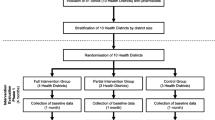Abstract
Objectives
Clinical decision making can be influenced by academic detailing, and it was hypothesised that this technique may be used to reduce simple errors when prescribing drugs of addiction. These prescriptions require specific details to be included, otherwise the prescription has to be returned to the prescriber and re-written, wasting the time of the dispenser and prescriber alike.
Methods
The legal requirements for the prescription of addictive drugs were used to define prescription errors. Prescription error rates at six hospitals were assessed, including a control and an intervention hospital where academic detailing was carried out. Prescription error rates were documented before and after an academic detailing visit to junior doctors, including the provision of a bookmark containing the requirements for these drugs. These errors were expressed as a percentage of the total written for a 4-week period.
Results
At the intervention hospital, there was a significant decrease in error rate (from 41% to 24%, P<0.0001) with an improvement in all the requirements stated on the bookmark. At this hospital, the confidence of the junior doctors on a self-rating 5-point scale in writing prescriptions for these drugs increased from a mean of 3.25 (95% CI 2.92–3.58) to 4.14 (95%CI 3.90–4.38) after the intervention (P=0.03). The baseline error rates at the other hospitals ranged from 25% to 46%, but the control hospital did not show a significant change in error rate over the same study period (P=0.66). A post-hoc review suggested that liquid preparations were more difficult to prescribe correctly, which in part accounted for the differences in error rate between hospitals.
Conclusions
Academic detailing appears to be a useful method of reducing erroneous hospital prescriptions; and, to our knowledge, this is a novel finding.
Similar content being viewed by others
References
Lesar TS, Briceland L, Stein DS (1997) Factors related to errors in medication prescribing. JAMA 277:312–317
Wilson RM, Runciman WB, Gibberd RW, Harrison BT, Newby L, Hamilton JD. (1995) The Quality in Australian Health Care Study. Med J Austral 163:458–471
Dean B (2002) Learning from prescribing errors. Qual Saf Health Care 11:258–260
Dean B, Schachter M, Vincet C, Barber N (2002) Causes of prescribing errors in hospital inpatients: a prospective study. Lancet 359:1373–1378
Soumerai SB, Avorn J (1990) Principles of educational outreach (“academic detailing”) to improve clinical decision making. JAMA 263:549–556
Thomson O’Brien MA, Oxman AD, Davis DA, Haynes RB, Freemantle N, Harvey EL (2001) Educational outreach visits: effects on professional practice and healthcare outcomes (Cochrane Review). In: The Cochrane Library, Issue 4. Update Software, Oxford
Illett KF, Johnson S, Greenhill G, Mullen L, Brockis J, Golledge CL, Reid DB (2000) Modification of general practitioner prescribing of antibiotics by use of a therapeutics adviser (academic detailer). Br J Clin Pharmacy 49:168–173
Freemantle N, Nazareth I, Eccles M, Wood J, Haines and the evidence-based outreach (EBOR) trialists. (2002) A randomised controlled trial of the effect of educational outreach by community pharmacists on prescribing in UK general practice. Br J Gen Pract 52:290–295
Mason J, Freemantle N, Nazareth I, Eccles M, Haines A, Drummond M (2001) When is it cost-effective to change the behavior of health professionals. JAMA 286:2988–2992
Acknowledgements
The contribution of the junior medical and pharmacy staff at Prince of Wales Hospital is gratefully acknowledged, as is the help of the hospital pharmacists: Sue Mackay, Maggie Gibson, Kerry Davison, Kathy Newnham and Rogini Ganess. Colleen Bruce kindly assisted with statistical advice. Conflict of interest: Partially funded by the Postgraduate Medical Council of NSW.
Author information
Authors and Affiliations
Corresponding author
Rights and permissions
About this article
Cite this article
Shaw, J., Harris, P., Keogh, G. et al. Error reduction: academic detailing as a method to reduce incorrect prescriptions. Eur J Clin Pharmacol 59, 697–699 (2003). https://doi.org/10.1007/s00228-003-0683-2
Received:
Accepted:
Published:
Issue Date:
DOI: https://doi.org/10.1007/s00228-003-0683-2




